
Breaking Barriers Safely: Revolutionary Insights into Focused Ultrasound and the Blood-Brain Barrier
2024-11-20
Author: Mei
Understanding the Blood-Brain Barrier
Once viewed merely as a physical barrier, the BBB is now recognized as a sophisticated component of the neurovascular unit (NVU). This intricate system comprises endothelial cells, glial cells, neurons, and the extracellular matrix, all collaborating to regulate the movement of essential nutrients and waste between blood and the brain. While crucial for brain protection, the BBB poses a significant hurdle: many potentially life-saving treatments cannot penetrate this barrier to reach their targets.
A Breakthrough with Low-Intensity Focused Ultrasound (LIFU)
Imagine if we could safely and temporarily open this barrier, allowing therapeutic agents to directly access the brain. Enter low-intensity focused ultrasound (LIFU), an innovative technology that utilizes targeted sound waves and microbubbles in the bloodstream. This combination creates brief, controlled openings in the BBB, facilitating the delivery of critical drugs or therapeutic molecules to treat conditions such as Alzheimer's, Parkinson's, and even aggressive brain tumors like glioblastoma.
Key Findings: The Neurovascular Unit's Dynamic Response
Researchers tracked the neurovascular unit's response across three crucial time points following LIFU exposure. Three hours after treatment, noticeable inflammation emerged in the brain, triggering immune cells such as microglia and lymphocytes—indicators of the body's natural response to perceived threats. By day seven, the brain demonstrated signs of repair, thanks to angiogenic factors like PDGFR-β and VEGF-A, which stimulate the growth of new blood vessels and restore vascular integrity.
The Promise of Angiogenesis in Recovery
Critically, this study highlights angiogenesis—the formation of new blood vessels—as a vital mechanism in repairing the neurovascular unit. The disruption of the BBB triggers a series of repair processes, evidenced by an increase in angiogenic markers that promote vascular restoration.
Implications for Treating Neurological Disorders
The findings underscore LIFU's safety and efficacy in temporarily opening the BBB, presenting newfound opportunities for enhanced drug delivery in the face of previously treatment-resistant neurological disorders. By mapping the neurovascular unit's response timeline to LIFU, researchers aim to strike a balance between maximizing therapeutic benefits and minimizing risks, particularly when considering repeated or long-term applications of this method.
Looking Ahead: A New Era in Brain Treatment
LIFU represents more than just progress in BBB research; it heralds a transformative shift in the treatment of neurological conditions. With careful application, this innovative technology not only enhances our understanding of the neurovascular unit’s resilience but also opens exciting avenues for patient care.



 Brasil (PT)
Brasil (PT)
 Canada (EN)
Canada (EN)
 Chile (ES)
Chile (ES)
 España (ES)
España (ES)
 France (FR)
France (FR)
 Hong Kong (EN)
Hong Kong (EN)
 Italia (IT)
Italia (IT)
 日本 (JA)
日本 (JA)
 Magyarország (HU)
Magyarország (HU)
 Norge (NO)
Norge (NO)
 Polska (PL)
Polska (PL)
 Schweiz (DE)
Schweiz (DE)
 Singapore (EN)
Singapore (EN)
 Sverige (SV)
Sverige (SV)
 Suomi (FI)
Suomi (FI)
 Türkiye (TR)
Türkiye (TR)